13
Evaluation of Ergonomic Design for the Visual Display Terminal Operator at Static Work Under FMCDM Environment
Bipradas Bairagi*
Department of Mechanical Engineering, Haldia Institute of Technology, Haldia, India
Abstract
This study explores a new fuzzy-based mathematical algorithm in analysis and evaluation of performance characteristics of static work station for accurate and right decision making. In this technique, diverse important criteria are identified and their importance weights are estimated by applying experience and opinion of the experts involved in the decision making process. Based on the criteria, sufficient numbers of alternative work stations are screened, and respective performance ratings are evaluated for further processing. The experts also assign relative importance to the selection criteria on the basis of their experience, knowledge, and perception. Thereafter, performance ratings of alternative work stations, weight of criteria, and importance weight of users are combined together with logical and soft-computing tool proposed in the study. The investigation found that the proposed method is useful for evaluation and selection of ergonomic design for static work under fuzzy multicriteria decision making environment.
Keywords: Ergonomic workplace evaluation, decision making, FMCDM, soft computing techniques
13.1 Introduction
The global market is constantly changing. The taste and preference of customers also vary at a rapid pace. Capturing the trend of customers’ or end users’ choice is now a crucial task for the managers of manufacturing organizations. Selection of suitable ergonomic design for the visual display terminal operators at static work under fuzzy multicriteria decision making environment is critical for the concerned decision makers. The selection of appropriate ergonomic design involves several alternatives, under multiple criteria considerations. Hence, such decision making procedure deserves implementation of suitable MCDM approach. If the decision is to make under subjective criteria associated with vagueness, imprecision, and ambiguity, then application of fuzzy set theory in combination with MCDM techniques is inevitable. A literature survey has been conducted on application of MCDM for decision making in ergonomic design selection that explores the literature gap.
Jain et al. applied an integrated multiple criteria decision making method for determining the risk level of musculoskeletal disorders among users of handled apparatus [1]. Eraslan et al. implemented a multiple-criteria decision making approach for the evaluation and selection of suitable design of office layout [2]. Mohanty et al. proposed a new fuzzy-based multiple attribute decision making method for the purpose of identifying the best product that conform ergonomic related considerations. The method was illustrated with the solution of a problem on office chair selection [3]. Halder et al. employed an integrated multiple criteria decision making approach for evaluation and selection of seat comfort with ergonomic considerations [4]. Mohammad et al. combined multiple criteria decision making technique with ergonomic technique for the purpose of risk measurement. The approach has been applied to assess the repetitive task [5].
A participatory approach is often the most effective way to decide the product features and accessories that are likely to have the greatest cost benefits for different groups of workers in an organization. Document holders, racks are often of great benefits for different groups of workers. There are many tools available for assessment of workstations where static work is carried out. Rapid Entire Body Assessment (REBA) is a postural analysis tool that gives a composite risk rating [6].
Postural analysis is a prevailing method for evaluating work actions. Musculoskeletal risk injury related to the postures (recorded), in the perspective of a complete ergonomic workplace appraisal, is a main aspect for executing change. A good number of postural analysis procedures include two, generally conflicting, qualities of generalization and compassion [7]. High generalization in a postural analysis technique may be compensated by little compassion. A requirement was professed within the range of postural analysis tools, particularly with sensitivity to the sort of volatile working postures found in health care and supplementary service industries. It directs to the growth of the postural analysis tool named Rapid Entire Body Assessment, REBA [8, 9].
Existing student’s workstation within classroom facilities does not fully support an up-to-date need of contemporary academic regulations. Several researchers have initiated appropriate student chair design following the standard physiological dimensions [10–12]. However, their contributions are mostly related toward the theoretical level and mainly in two-dimensional and not three-dimensional geometric space. Basically, existing users’ chairs are designed mostly in a traditional way and are not much considered according to ergonomics principles [13]. One of the most important needs for workspace chair design is to consider the relationship between the users’ physical standards and chair’s functional dimensions [14–16].
Production and inventory costs are important consideration in designing visual display workspace, but at the same time, it is also important to relate anthropometric data and ergonomics during design [17–19]. Extensive researches in the area of school chair and desk have been conducted in the Scandinavian countries including Denmark and Sweden and the drift is also noticed in Germany, France and Switzerland [20].
The initial point to design and develop an ergonomic users’ chair, visual display space is to explore how the dimensions and styles of the chairs and desks are essentially used in the working environment to replicate the body dimensions and the functional requirements of present days’ huge working population [21, 22]. Incorporating multicriteria-based soft computing technique for safe product design considering ergonomic point of views is newly introduced in this study. Basically ergonomic design is to consider the human factor and man-machine interface.
The analysis of the relevant literature survey reveals that fuzzy multicriteria decision making approach have not been used so far to evaluate and select ergonomic alternative design, at least at a satisfactory level. Multicriteria decision making process using fuzzy set theory may be a potential tool in this purpose. The manufacturing organizations are facing the problem of proper decision making regarding the selection of appropriate alternatives of ergonomic designs. It is evident from the above literature survey that suitable MCDM approach is necessary for making appropriate decision involving ergonomic considerations.
The objective of the current investigation is to develop a decision making framework that can be an essential tool in solving problem regarding selection of ergonomic design for the visual display terminal operator at static work under FMCDM environment.
The rest of the chapter is divided into some sections as follows. Section 13.2 proposes a new algorithm. Section 13.3 describes an illustrative example on ergonomic design evaluation and significant discussions. Lastly section 13.4 highlights some essential conclusions and direction of future research.
13.2 Proposed Algorithm
This research work proposes a novel algorithm consisting of 10 interrelated steps under FMCDM environment as described below.
Step 1: The algorithm starts with the formation of decision matrix comprising of performance rating for the alternatives with respect to decision making criteria. The performance ratings of alternatives are assessed by users, experts, or decision makers in linguistic variables. The decision matrix is constructed as follows.
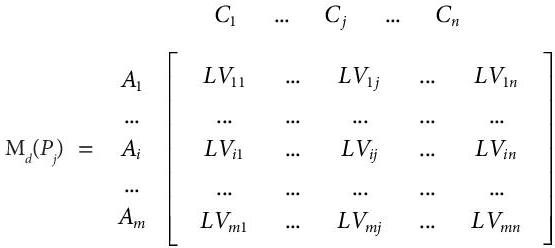
LVij denotes linguistic variable expressing performance rating of alternative Ai with respect to criterion Cj estimated by user or experts Ej. n is number of criteria and m is number of alternatives. Linguistic variables have five degrees which are transformed into five corresponding triangular fuzzy numbers (TFNs) as represented in Table 13.1.
Step 2: Formation of weight matrix for assigning importance weight to the criteria estimated by a committee of experts, decision makers and users. The proposed weight matrix for measuring criteria importance is formed as follows.
Table 13.1 Five degrees of linguistic variables for assessing subjective attributes.
| Description | Abbreviation | Triangular fuzzy number |
| Very comfortable | VC | (80,90,100) |
| Comfortable | C | (60,70,80) |
| Average | A | (40,50,60) |
| Not comfortable | NC | (20,30,40) |
| Very uncomfortable | VU | (0,10,20) |
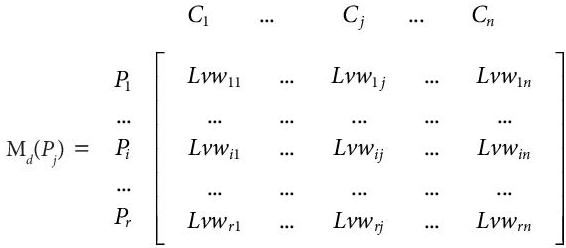
Md(Pi) is the decision matrix formed by the experts Pi. Lvwij denotes the linguistic variables for weights of criterion Cj, assessed by ith experts or user, where n is number of criteria and r is number of experts, decision makers, or users. Description of 5 degrees of linguistic variables, abbreviation, and corresponding TFN for weights are presented and described in the following Table 13.2.
Table 13.2 Linguistic variables, abbreviation and TFN for weights.
| Description | Abbreviation | Triangular fuzzy number |
| Extremely important | EI | (0.8,0.9,1) |
| Very important | VI | (0.6,0.7,0.8) |
| important | I | (0.4,0.5,0.6) |
| Less-important | LI | (0.2,0.3,0.4) |
| Unimportant | UI | (0, 0.1,0.2) |
Step 3: Conversion of linguistic terms of decision matrix into triangular fuzzy numbers (TFN) as per proposed conversion table as presented in step 2. A decision matrix comprising TFNs is represented as follows.
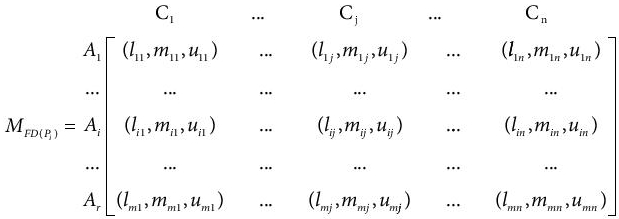
MFD(Pi) is the fuzzy decision matrix form by experts Pi. Here, (lij ,mij ,uij) denotes performance rating in triangular fuzzy number for alternatives Ai with respect to criteria Cj and assessed by ith user (expert) in the specified five degrees of gradation. The number of decision matrix comprising TFN is equal to the number of decision matrix comprising linguistic variables. In other words, the number of decision matrices comprising TFN is equal to the users or evaluators.
Step 4: Conversion of linguistic terms of the weight matrix into triangular fuzzy numbers (TFN) is accomplished as per proposed conversion table as presented in step 2. The weight matrix comprising TFNs is represented as follows.
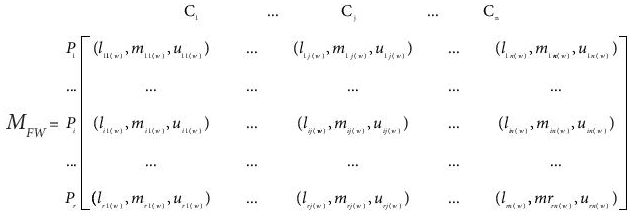
where (lij(w),mijw(w),uij(w)) denotes the weight in triangular fuzzy number for the criterion Cj and assessed by ith person (expert, user or DM) in the specified five degrees of gradation.
Step 5: Determination of average fuzzy decision matrix: Average fuzzy decision matrix is calculated from the r number of decision matrices as assessed by the experts using the proposed formula.
Where ![]() denotes the average fuzzy performance rating, lij, mij, uij are lower, middle and upper values of ith fuzzy performance rating, respectively. r is number of experts involved in decision making process, i varies from 1 to r, j is associated with criteria.
denotes the average fuzzy performance rating, lij, mij, uij are lower, middle and upper values of ith fuzzy performance rating, respectively. r is number of experts involved in decision making process, i varies from 1 to r, j is associated with criteria.
Step 6: Determination of average fuzzy weight matrix: Average fuzzy weight matrix is calculated from the weight matrix of order r×n assessed by r experts. The average weight matrix turns to a 1×n order matrix of fuzzy numbers, which can be determined by the following formula.
where ![]() denotes the average fuzzy weight of jth criteria. lij(w), mij(w), uij(w) are lower, middle, and upper values of the fuzzy weight assessed by ith person (expert) involved in decision making process.
denotes the average fuzzy weight of jth criteria. lij(w), mij(w), uij(w) are lower, middle, and upper values of the fuzzy weight assessed by ith person (expert) involved in decision making process.
Step 7: Normalization of fuzzy performance rating: Based on the desired value, criteria can be divided in three categories, i.e., benefit criteria (higher value is desired), non-benefit criteria (lower numerical value is desired) and target value oriented criteria (neither higher nor lower value is desired instead a certain fixed value is expected). Since nature of the criteria is different, hence unique normalization technique for each category of criteria is used. Following formulae are proposed for performing normalization process.
Step 8: Normalization of weight: For the compatibility of weight with the performance rating, the following normalization technique is introduced.
where vj(u)max denotes the maximum upper value of all TFNs expressing weight criteria.
Step 9: Performance contribution of individual criterion: The normalization process is carried out in such a way that all the fuzzy performance ratings are now in benefit sense irrespective of nature of criteria. That is why for finding out the individual contribution of criteria in performance measurement is carried out using a common unique formula as proposed follows.

Step 10: Performance Index: The performance index is the measurement in performance, ranking and selection. The current investigation advocates the following technique in calculation performance index (PI) by integrating performance contribution of each criterion toward the evaluation of alternatives.
Here, PIi denotes performance index of ith alternative. Performance index has its beneficial sense, that is, higher value is desirable. Therefore alternatives are arranged in the descending order of their respective PI value. The alternative with the highest value of performance index is considered the best alternative. The alternative with the least value of performance index is considered as the worst alternative, and so on.
This proposed algorithm is now demonstrated with a suitable example on selection of ergonomic design problem in the next section.
13.3 An Illustrative Example on Ergonomic Design Evaluation
An East Indian manufacturing organization plans to select the best sitting chairs with respect to ergonomic design considerations. After a wide range of survey, the company collects the following information by questionnaires to four potential users in a certain demographical region. The three users have different physiological heights is formed. User 1 is 5’, User 2 is 5’6’’ and User 3 is 6’. The decision making committee selects seven important criteria as follows: C1, Seat Height (SH); C2, Back Rest Size (BRS); C3, Back Rest Angle (BRA); C4, Arm Rest (AR); C5, Material (M); C6, Load Capacity (LC); and C7, Cost (C). All criteria are of qualitative/intangible categories. The criteria have been assessed using five degrees of linguistic variables along with the corresponding abbreviation and triangular fuzzy number as furnished in Table 13.1. Five degrees of linguistic variables, abbreviation along with corresponding TFN for weights are presented in Table 13.2.
All the criteria under consideration are subjective and vague. Linguistic variables are used by the decision makers for the assessment of the performance rating of the alternatives with respect to the criteria. Decision maker 1 assesses the alternatives with respect to criteria in terms of five degree linguistic variables and forms a decision matrix, which is shown in Table 13.3.
If we analyze Table 13.3 where user 1 has judged the seating chair with linguistic variables, many conflicting factors arises for consideration. Here for chair 1 (Alternative 1), the cost, back rest size, back rest angle are near about desired one but the criteria like seat height, load capacity, etc. are not good in respect of physiological application considering the height of the user. Moreover, the properties of chair 1 will provide postural fatigue to the user 1. But in case of user 3, chair 1 is not comfortable in respect of load capacity, back rest angle, back rest size but its performance is near to desired one in respect of seat height, arm rest. So same chair can be comfortable in respect to different criteria to different users, as well as that cannot be desired in respect to other criteria for the same users.
Table 13.3 Decision matrix in linguistic variables assessed by user (expert) 1.
| By user 1 | Criteria | ||||||
| C1 | C2 | C3 | C4 | C5 | C6 | C7 | |
| A1 Alternatives A2 A3 A4 | VC | NU | NC | VC | A | NC | A |
| A | A | A | C | VC | C | VU | |
| VU | C | VC | A | VU | VC | NC | |
| C | VC | C | A | C | C | NC | |
Decision matrix in terms of linguistic variable estimated by users 2 and 3 are accommodated in Table 13.4 and Table 13.5, respectively. The linguistic variables in Tables 13.3, 13.4, and 13.5 are now converted into corresponding TFNs.
The importance of the seven criteria has been estimated by the three users using prescribed five degrees of linguistic variables. Weights in linguistic variables estimated by the users P1, P2, and P3 are shown in Table 13.6. The abbreviations bear the same meaning as describe before. Weights in linguistic variables are now converted in terms of triangular fuzzy numbers as per the conversion rules as describe before.
Table 13.4 Decision matrix in terms of linguistic variable estimated by user 2.
| Estimated by user 2 | Criteria | ||||||||
| C1 | C2 | C3 | C4 | C5 | C6 | C7 | |||
| Alternatives | A1 | A | V C | C | VU | VC | NC | C | |
| A2 | VC | C | VC | C | C | A | NC | ||
| A3 | A | A | A | VC | A | C | A | ||
| A4 | C | A | A | NC | C | C | NC | ||
The abbreviations bear the meaning as prescribed in Table 13.1.
Table 13.5 Decision matrix in terms of linguistic variable estimated by user 3.
| Estimated user 3 | Criteria | |||||||
| C1 | C2 | C3 | C4 | C5 | C6 | C7 | ||
| Alternatives | A1 | VC | NU | NC | VC | A | NC | A |
| A2 | A | A | A | C | VC | C | VU | |
| A3 | VU | C | VC | A | VU | VC | NC | |
| A4 | C | VC | C | A | C | C | NC | |
The abbreviations bear the meaning as prescribed in Table 13.1.
Table 13.6 Weights in linguistic variables estimated by users.
| Experts | C1 | C2 | C3 | C4 | C5 | C6 | C7 |
| P1 | EI | VI | LI | I | VI | I | UI |
| P2 | VI | I | EI | UI | I | LI | I |
| P3 | LI | EI | VI | LI | LI | EI | EI |
Average fuzzy performance rating and average fuzzy weight matrix are computed as per equations (13.5) and equation (13.6) respectively. Normalized fuzzy performance rating and normalized fuzzy weight are calculated using equations (13.7) to equation (13.9) and equation (13.10). Computation of performance contribution of the criteria is carried out using a common unique equation (13.11) and presented in Table 13.7. Performance indices of each alternative design are calculated using equation (13.13), and the results are shown in Table 13.8. The term performance index is introduced in measuring performance, ranking, and selection. The current investigation advocates the following technique in calculation performance index (PI) by integrating performance contribution of each criterion toward the evaluation of alternatives. Figure 13.1 depicts performance index of alternatives. The alternatives are arranged as per the descending order of their performance indices value. It is clearly seen that A3>A2>A4>A1. According to their value, the third alternative has the highest score. Calculation shows that A3 is the best alternative of the four, A1 is the worst one, and so on. The ranking order is also graphically shown in Figure 13.2. Comprising all the factors and facts with this new set of algorithm, the selection has been conducted, which can analyze and solve complex problem into one point of perseverance.
Table 13.7 Performance contribution of individual criterion.
| Criteria | ||||||||
| C1 | C2 | C3 | C4 | C5 | C6 | C7 | ||
| Alternative | A1 | 16 | 18 | 17 | 12 | 10.73 | 8.4 | 7.7 |
| A2 | 15 | 16 | 17 | 9.8 | 11.47 | 11 | 12 | |
| A3 | 16 | 20 | 18 | 9.1 | 9.39 | 13 | 10 | |
| A4 | 15 | 15 | 16 | 11 | 10.73 | 13 | 11 | |
Table 13.8 Performance index and ranking order of alternatives.
| Alternative | Performance index value | Ranking order | |
| Alternatives | A1 | 90.94 | 4 |
| A2 | 93.53 | 2 | |
| A3 | 95.28 | 1 | |
| A4 | 92.32 | 3 | |

Figure 13.1 Performance index of alternatives.
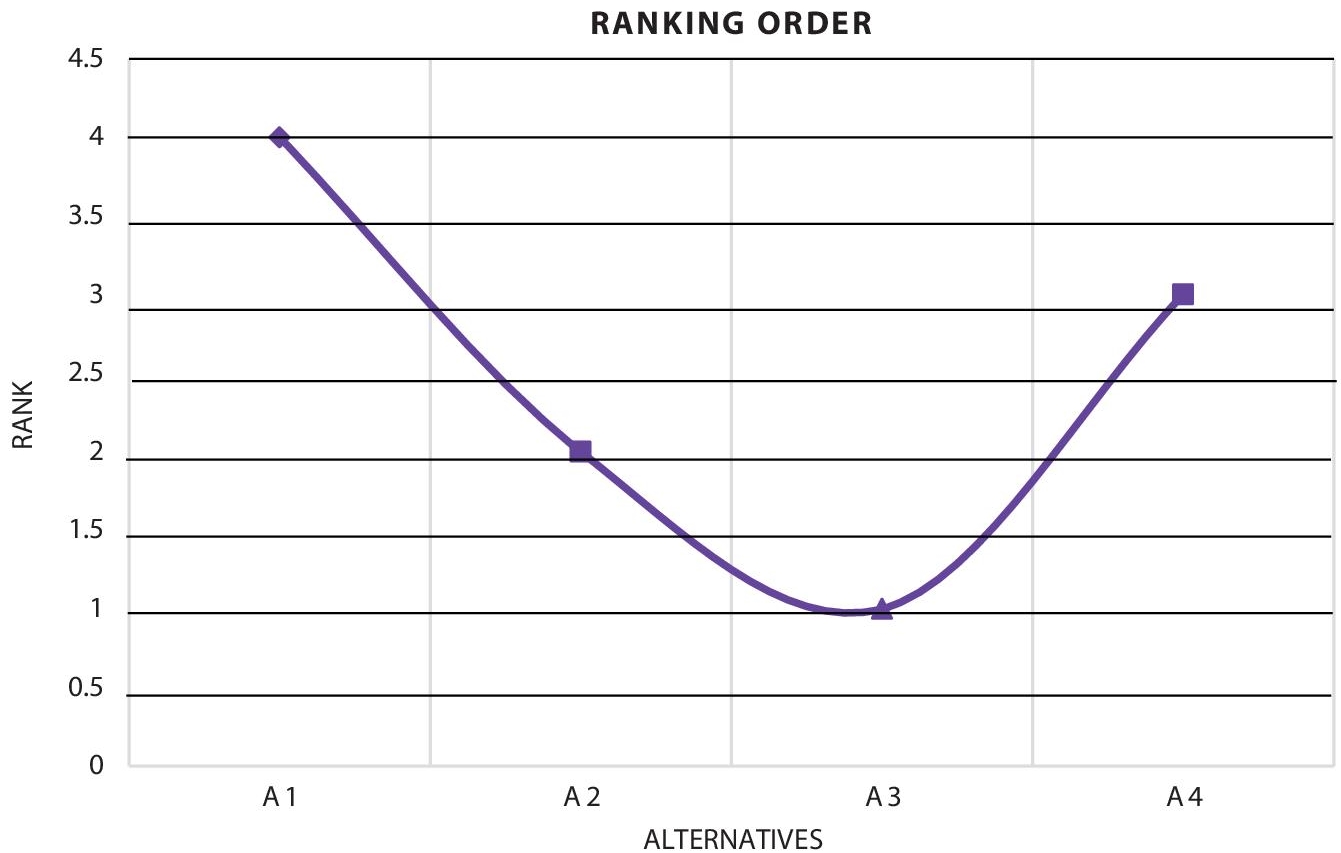
Figure 13.2 Ranking order of the alternatives.
13.4 Conclusions
The present state of knowledge of ergonomically design selection is mainly limited by consideration of objective criteria with crisp value. The current investigation explores a technique having the ability of incorporation of target-based criteria, benefit criteria and cost criteria under fuzzy environment with vague information. Thus, this study contributes new concept in the domain of knowledge by introducing an innovative technique capable of judging intangible factors as per the requirement of users in varying social environment. The proposed multicriteria decision making approach is useful and effective in evaluation and selection of the best alternative under fuzzy environment. This technique may be an important aid of the decision makers for selection of the best ergonomic design. Consideration of interdependent criteria involving and heterogeneous decision makers might be direction of future research.
References
- 1. Jain, R., Rana, K.B., Meena, M.L., An integrated multi-criteria decision-making approach for identifying the risk level of musculoskeletal disorders among handheld device users. Soft Comput., 2021, https://doi.org/10.1007/s00500-021-05592-w.
- 2. Eraslan, E., Güneşli, İ., Khatib, W., The evaluation of appropriate office layout design with MCDM techniques. SN Appl. Sci., 2388, 2020, https://doi.org/10.1007/s42452-020-2181-x.
- 3. Mohanty, P.P., Mahapatra, S.S., Mohanty, A., Sthitapragyan, A novel multi-attribute decision making approach for selection of appropriate product conforming ergonomic considerations. Oper. Res. Perspect., 5, 82–93, 2018.
- 4. Halder, P., Karmaker, C., Rahman, M., Integrated Approach of Ergonomics and MCDM into Truck Drivers’ Seat Comfort: A Case Study in Bangladesh International Conference on Mechanical, Industrial and Energy Engineering 2018, Khulna Bangladesh, 23-24 December 2018.
- 5. Mohammad, K., Majid, A., Alireza, K., Saeedeh, M., Integrating the ergonomics techniques with multi criteria decision making as a new approach for risk management: An assessment of repetitive tasks-entropy case study. J. Res. Health Sci., 16, 2, 85–89, 2016.
- 6. Hignett, M.A., 2000REBA (Rapid Entire Body Assessment). Appl. Ergon., 31, 201–205, 2000.
- 7. Fransson-Hall, C., Gloria, R., Kilbom, A., Winkel, J., A portable ergonomic observation method (PEO) for computerised on-line recording of postures and manual handling. Appl. Ergon., 26, 2, 93–100, 1995.
- 8. Karhu, O., Kansi, P., Kuorinka, I., Correcting working postures in industry: A practical method for analysis. Appl. Ergonomics, 8, 199–201, 1977.
- 9. Waters, T.R., Putz-Anderson, V., Garg, A., Fine, L.J., Revised NIOSH equation for the design and evaluation of manual lifting tasks. Ergonomics, 36, 749–776, 1993.
- 10. Habibi, E., Asaadi, Z., Hosseini, M., Proportion of elementary school pupils anthropometric characteristics with dimensions of classroom furniture in Isfahan, Iran. J. Res. Med. Sci., 16, 98–104, 2011.
- 11. Macedo, A., Morais, A.V., Martins, H.F., Martins, I.C., Pais, S.M., Mayan, O.S., Match between classroom dimensions and students anthropome-try: Re-equipment according to European educational furniture standard, Human Factors. Int. J. Hum. Factors Ergon. Soc., 57, 48–60, 2015.
- 12. Castellucci, H.I., Arezes, P.M., Viviani, C.A., Mismatch between classroom furniture and anthropometric measures in Chilean schools, Appl. Ergon., 41, 563–568, 2010.
- 13. Mohamed-Thariq, M.G., Munasinghe, H.P., Abeysekra, J.D., Designing chairs with mounted desktop for university students: Ergonomics and comfort. Int. J. Ind. Ergon., 40, 8–18, 2010.
- 14. Xu, J. and Zhang, H., Modern office furniture design based on ergonomics. Adv. Mater. Res., 62, 57–62, 2013.
- 15. Sepehri, S., Habib, A.H., Shakerian, S., The relationship between ergonomic chair and musculoskeletal disorders in north of Khuzestan’s students. Eur. J. Exp. Biol., 3, 181–187, 2013.
- 16. Shah, R.M., Bhuiyan, M.A.U., Debnath, R., Iqbal, M., Shamsuzzoha, A., Ergonomics issues in furniture design: A case of a tabloid chair, in: Proc. of the 23rd International Conference on Flexible Automation and Intelligent Manufacturing (FAIM 2013), June 26th - 28th, Porto, Portugal, pp. 91–104, 2013.
- 17. Altaboli, I., Ahmida, R., Elmgrab, M., Immraga, H., Othman, R., Anthropometric evaluation of proposed improved designs of the classroom desk for Benghazi primary schools, in: Proc. of the Human Factors and Ergonomics Society Annual Meeting, vol. 59, pp. 426–430, 2015.
- 18. Tunay, M. and Melemez, K., An analysis of biomechanical and anthropometric parameters on classroom furniture design. Afr. J. Biotechnol., 78, 1081– 1086, 2008.
- 19. Lane, K. and Richardson, M., Classroom furniture and postural alignment. Educ. Facil. Planner, 21, 22–23, 1993.
- 20. Mandal, A., The correct height of school furniture. Hum. Factors, 24, 257– 269, 1982.
- 21. Toomingas, I. and Gavhed, D., Workstation layout and work postures at call centres in Sweden in relation to national law, EU-directives and ISO-standards, and to operators comfort and symptoms. Int. J. Ind. Ergon., 38, 1051–1061, 2008.
- 22. Linton, S., Hellsing, A., Halme, T., The effects of ergonomically designed school furniture on pupils attitudes, symptoms and behavior. Appl. Ergon., 25, 299–304, 1994.
Note
- * Email: [email protected]





